Leadership Skills for Managers: Theories, Styles, and Practice
VerifiedAdded on 2020/04/01
|10
|2654
|117
Essay
AI Summary
This essay delves into the core concepts of leadership, examining various theories such as the Great Man theory, trait theory, behavioral theory, contingency theory, transactional leadership, and transformational leadership. It explores different leadership styles, including autocratic, democratic, transactional, and transformational approaches, highlighting their attributes and behaviors. The essay emphasizes the importance of leadership qualities like vision, communication skills, motivation, interpersonal skills, problem-solving abilities, and decision-making in achieving organizational goals. It then discusses the practical application of leadership within teams and organizations, focusing on team building, fostering a positive organizational culture, and managing change effectively. The essay also includes a self-assessment of leadership skills, identifying areas for improvement, such as interpersonal skills, decision-making, and problem-solving, and concludes by reiterating the significance of leadership in inspiring and motivating individuals to contribute to organizational success. The author aims to develop these skills to become a more effective leader.

Leadership for Manager
1
1
Paraphrase This Document
Need a fresh take? Get an instant paraphrase of this document with our AI Paraphraser
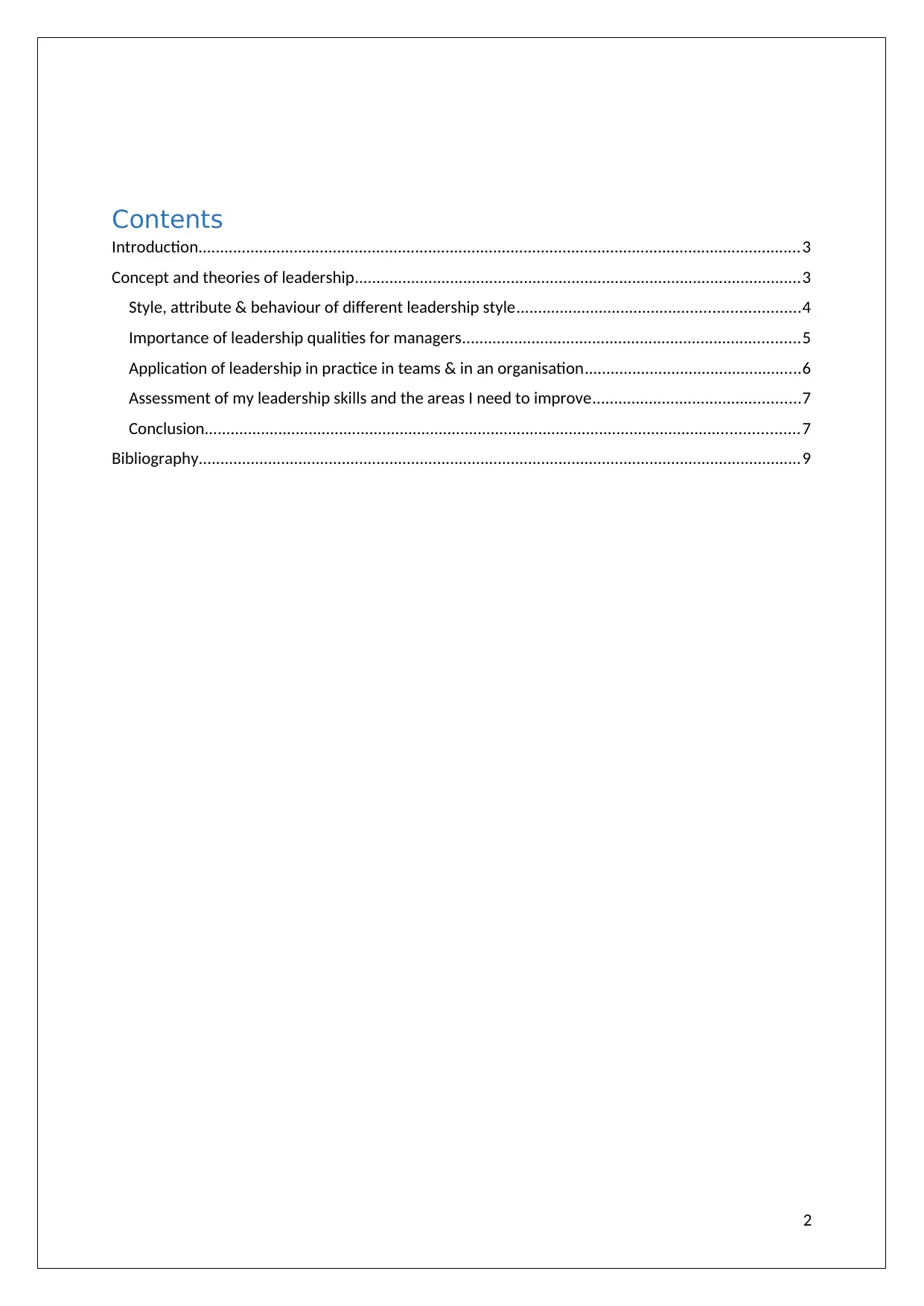
Contents
Introduction...........................................................................................................................................3
Concept and theories of leadership.......................................................................................................3
Style, attribute & behaviour of different leadership style.................................................................4
Importance of leadership qualities for managers..............................................................................5
Application of leadership in practice in teams & in an organisation..................................................6
Assessment of my leadership skills and the areas I need to improve................................................7
Conclusion.........................................................................................................................................7
Bibliography...........................................................................................................................................9
2
Introduction...........................................................................................................................................3
Concept and theories of leadership.......................................................................................................3
Style, attribute & behaviour of different leadership style.................................................................4
Importance of leadership qualities for managers..............................................................................5
Application of leadership in practice in teams & in an organisation..................................................6
Assessment of my leadership skills and the areas I need to improve................................................7
Conclusion.........................................................................................................................................7
Bibliography...........................................................................................................................................9
2
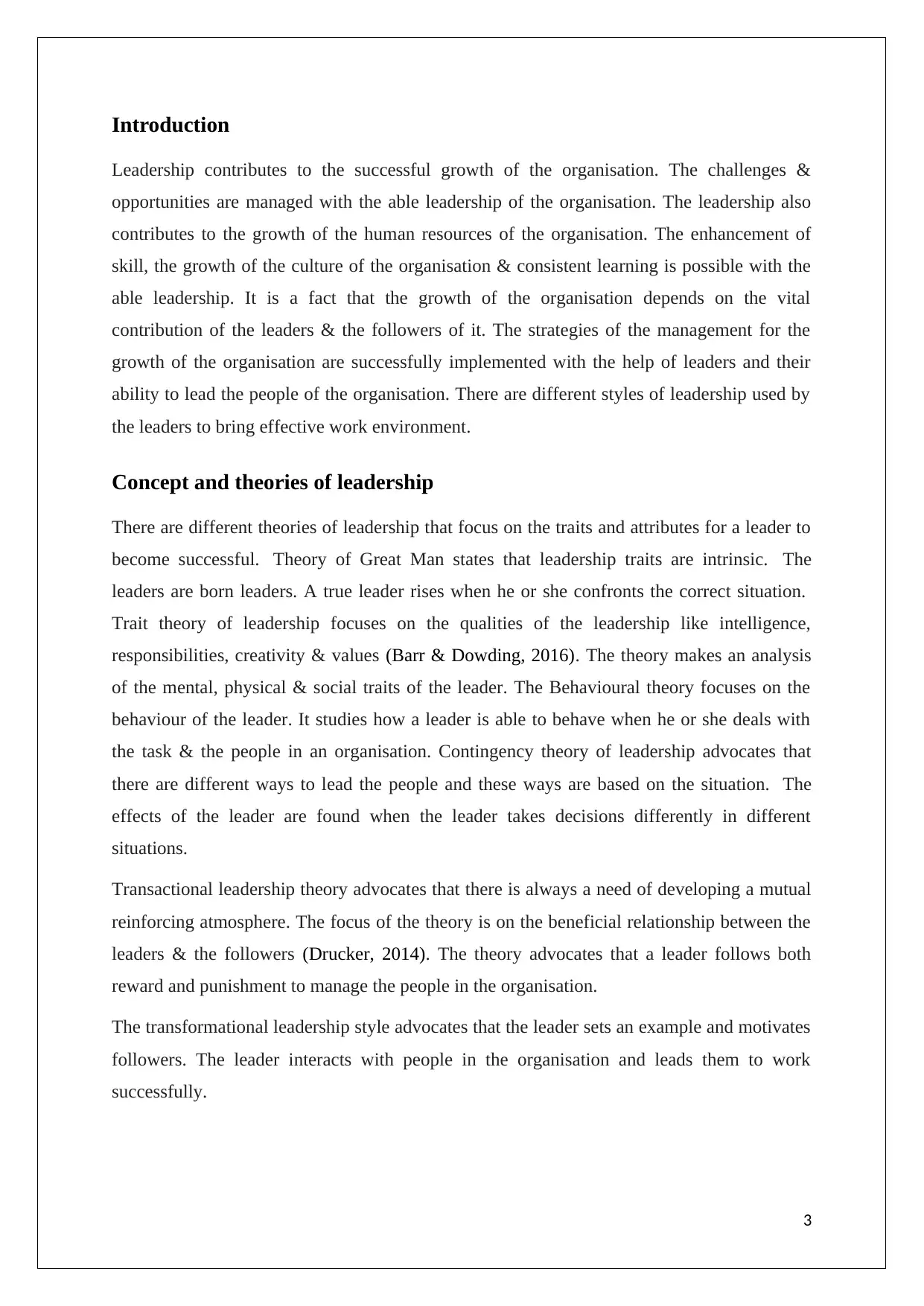
Introduction
Leadership contributes to the successful growth of the organisation. The challenges &
opportunities are managed with the able leadership of the organisation. The leadership also
contributes to the growth of the human resources of the organisation. The enhancement of
skill, the growth of the culture of the organisation & consistent learning is possible with the
able leadership. It is a fact that the growth of the organisation depends on the vital
contribution of the leaders & the followers of it. The strategies of the management for the
growth of the organisation are successfully implemented with the help of leaders and their
ability to lead the people of the organisation. There are different styles of leadership used by
the leaders to bring effective work environment.
Concept and theories of leadership
There are different theories of leadership that focus on the traits and attributes for a leader to
become successful. Theory of Great Man states that leadership traits are intrinsic. The
leaders are born leaders. A true leader rises when he or she confronts the correct situation.
Trait theory of leadership focuses on the qualities of the leadership like intelligence,
responsibilities, creativity & values (Barr & Dowding, 2016). The theory makes an analysis
of the mental, physical & social traits of the leader. The Behavioural theory focuses on the
behaviour of the leader. It studies how a leader is able to behave when he or she deals with
the task & the people in an organisation. Contingency theory of leadership advocates that
there are different ways to lead the people and these ways are based on the situation. The
effects of the leader are found when the leader takes decisions differently in different
situations.
Transactional leadership theory advocates that there is always a need of developing a mutual
reinforcing atmosphere. The focus of the theory is on the beneficial relationship between the
leaders & the followers (Drucker, 2014). The theory advocates that a leader follows both
reward and punishment to manage the people in the organisation.
The transformational leadership style advocates that the leader sets an example and motivates
followers. The leader interacts with people in the organisation and leads them to work
successfully.
3
Leadership contributes to the successful growth of the organisation. The challenges &
opportunities are managed with the able leadership of the organisation. The leadership also
contributes to the growth of the human resources of the organisation. The enhancement of
skill, the growth of the culture of the organisation & consistent learning is possible with the
able leadership. It is a fact that the growth of the organisation depends on the vital
contribution of the leaders & the followers of it. The strategies of the management for the
growth of the organisation are successfully implemented with the help of leaders and their
ability to lead the people of the organisation. There are different styles of leadership used by
the leaders to bring effective work environment.
Concept and theories of leadership
There are different theories of leadership that focus on the traits and attributes for a leader to
become successful. Theory of Great Man states that leadership traits are intrinsic. The
leaders are born leaders. A true leader rises when he or she confronts the correct situation.
Trait theory of leadership focuses on the qualities of the leadership like intelligence,
responsibilities, creativity & values (Barr & Dowding, 2016). The theory makes an analysis
of the mental, physical & social traits of the leader. The Behavioural theory focuses on the
behaviour of the leader. It studies how a leader is able to behave when he or she deals with
the task & the people in an organisation. Contingency theory of leadership advocates that
there are different ways to lead the people and these ways are based on the situation. The
effects of the leader are found when the leader takes decisions differently in different
situations.
Transactional leadership theory advocates that there is always a need of developing a mutual
reinforcing atmosphere. The focus of the theory is on the beneficial relationship between the
leaders & the followers (Drucker, 2014). The theory advocates that a leader follows both
reward and punishment to manage the people in the organisation.
The transformational leadership style advocates that the leader sets an example and motivates
followers. The leader interacts with people in the organisation and leads them to work
successfully.
3
⊘ This is a preview!⊘
Do you want full access?
Subscribe today to unlock all pages.

Trusted by 1+ million students worldwide
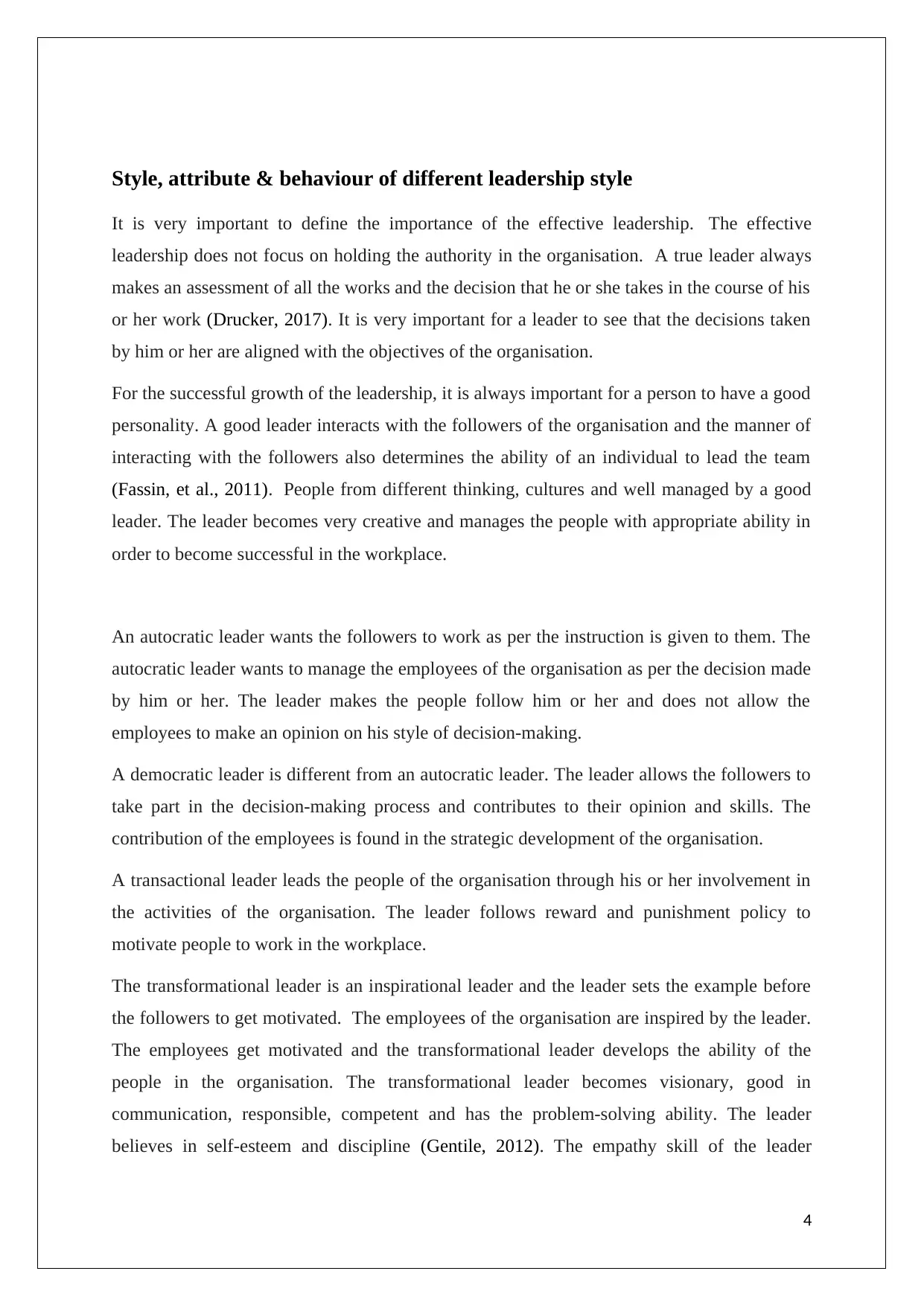
Style, attribute & behaviour of different leadership style
It is very important to define the importance of the effective leadership. The effective
leadership does not focus on holding the authority in the organisation. A true leader always
makes an assessment of all the works and the decision that he or she takes in the course of his
or her work (Drucker, 2017). It is very important for a leader to see that the decisions taken
by him or her are aligned with the objectives of the organisation.
For the successful growth of the leadership, it is always important for a person to have a good
personality. A good leader interacts with the followers of the organisation and the manner of
interacting with the followers also determines the ability of an individual to lead the team
(Fassin, et al., 2011). People from different thinking, cultures and well managed by a good
leader. The leader becomes very creative and manages the people with appropriate ability in
order to become successful in the workplace.
An autocratic leader wants the followers to work as per the instruction is given to them. The
autocratic leader wants to manage the employees of the organisation as per the decision made
by him or her. The leader makes the people follow him or her and does not allow the
employees to make an opinion on his style of decision-making.
A democratic leader is different from an autocratic leader. The leader allows the followers to
take part in the decision-making process and contributes to their opinion and skills. The
contribution of the employees is found in the strategic development of the organisation.
A transactional leader leads the people of the organisation through his or her involvement in
the activities of the organisation. The leader follows reward and punishment policy to
motivate people to work in the workplace.
The transformational leader is an inspirational leader and the leader sets the example before
the followers to get motivated. The employees of the organisation are inspired by the leader.
The employees get motivated and the transformational leader develops the ability of the
people in the organisation. The transformational leader becomes visionary, good in
communication, responsible, competent and has the problem-solving ability. The leader
believes in self-esteem and discipline (Gentile, 2012). The empathy skill of the leader
4
It is very important to define the importance of the effective leadership. The effective
leadership does not focus on holding the authority in the organisation. A true leader always
makes an assessment of all the works and the decision that he or she takes in the course of his
or her work (Drucker, 2017). It is very important for a leader to see that the decisions taken
by him or her are aligned with the objectives of the organisation.
For the successful growth of the leadership, it is always important for a person to have a good
personality. A good leader interacts with the followers of the organisation and the manner of
interacting with the followers also determines the ability of an individual to lead the team
(Fassin, et al., 2011). People from different thinking, cultures and well managed by a good
leader. The leader becomes very creative and manages the people with appropriate ability in
order to become successful in the workplace.
An autocratic leader wants the followers to work as per the instruction is given to them. The
autocratic leader wants to manage the employees of the organisation as per the decision made
by him or her. The leader makes the people follow him or her and does not allow the
employees to make an opinion on his style of decision-making.
A democratic leader is different from an autocratic leader. The leader allows the followers to
take part in the decision-making process and contributes to their opinion and skills. The
contribution of the employees is found in the strategic development of the organisation.
A transactional leader leads the people of the organisation through his or her involvement in
the activities of the organisation. The leader follows reward and punishment policy to
motivate people to work in the workplace.
The transformational leader is an inspirational leader and the leader sets the example before
the followers to get motivated. The employees of the organisation are inspired by the leader.
The employees get motivated and the transformational leader develops the ability of the
people in the organisation. The transformational leader becomes visionary, good in
communication, responsible, competent and has the problem-solving ability. The leader
believes in self-esteem and discipline (Gentile, 2012). The empathy skill of the leader
4
Paraphrase This Document
Need a fresh take? Get an instant paraphrase of this document with our AI Paraphraser
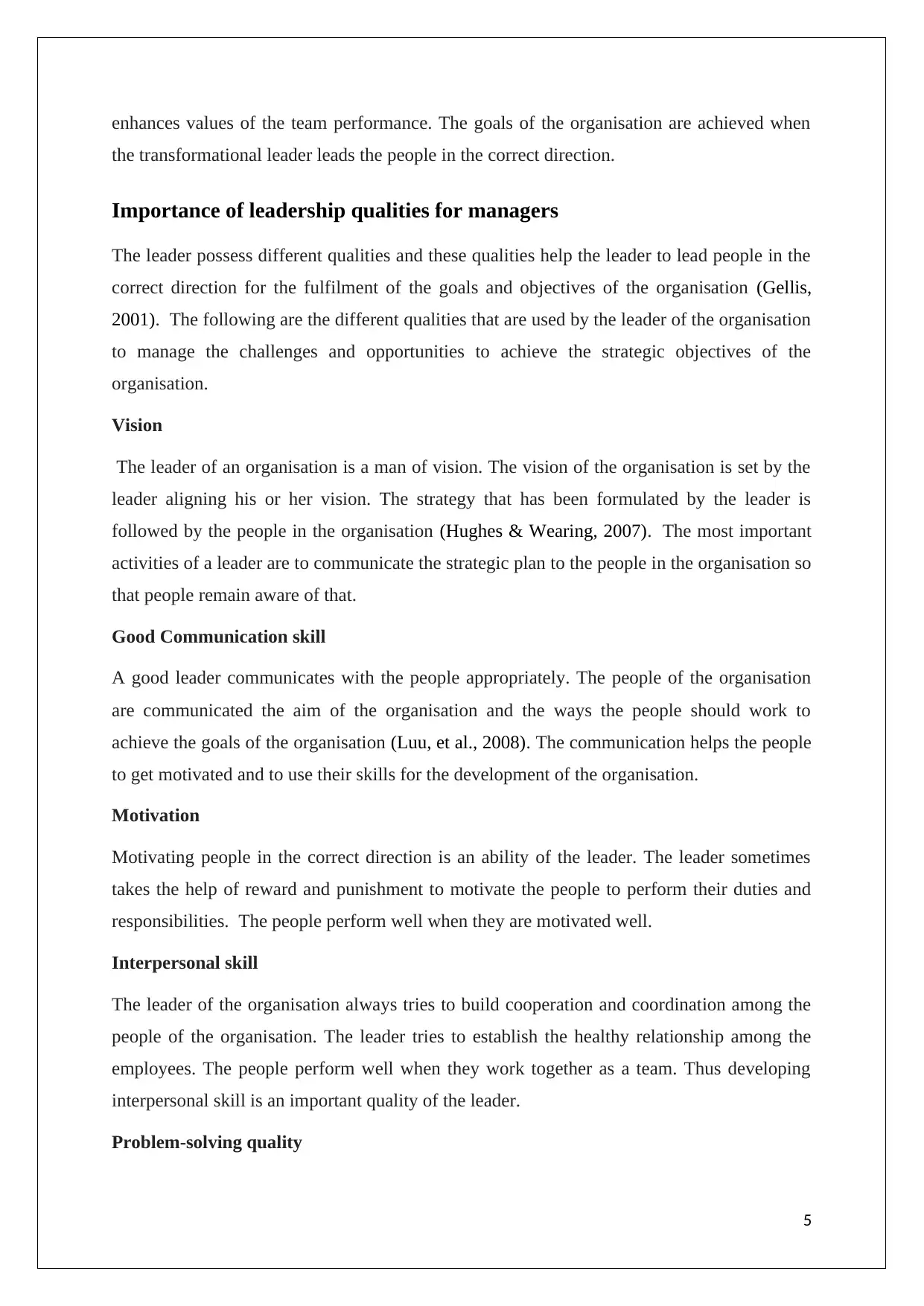
enhances values of the team performance. The goals of the organisation are achieved when
the transformational leader leads the people in the correct direction.
Importance of leadership qualities for managers
The leader possess different qualities and these qualities help the leader to lead people in the
correct direction for the fulfilment of the goals and objectives of the organisation (Gellis,
2001). The following are the different qualities that are used by the leader of the organisation
to manage the challenges and opportunities to achieve the strategic objectives of the
organisation.
Vision
The leader of an organisation is a man of vision. The vision of the organisation is set by the
leader aligning his or her vision. The strategy that has been formulated by the leader is
followed by the people in the organisation (Hughes & Wearing, 2007). The most important
activities of a leader are to communicate the strategic plan to the people in the organisation so
that people remain aware of that.
Good Communication skill
A good leader communicates with the people appropriately. The people of the organisation
are communicated the aim of the organisation and the ways the people should work to
achieve the goals of the organisation (Luu, et al., 2008). The communication helps the people
to get motivated and to use their skills for the development of the organisation.
Motivation
Motivating people in the correct direction is an ability of the leader. The leader sometimes
takes the help of reward and punishment to motivate the people to perform their duties and
responsibilities. The people perform well when they are motivated well.
Interpersonal skill
The leader of the organisation always tries to build cooperation and coordination among the
people of the organisation. The leader tries to establish the healthy relationship among the
employees. The people perform well when they work together as a team. Thus developing
interpersonal skill is an important quality of the leader.
Problem-solving quality
5
the transformational leader leads the people in the correct direction.
Importance of leadership qualities for managers
The leader possess different qualities and these qualities help the leader to lead people in the
correct direction for the fulfilment of the goals and objectives of the organisation (Gellis,
2001). The following are the different qualities that are used by the leader of the organisation
to manage the challenges and opportunities to achieve the strategic objectives of the
organisation.
Vision
The leader of an organisation is a man of vision. The vision of the organisation is set by the
leader aligning his or her vision. The strategy that has been formulated by the leader is
followed by the people in the organisation (Hughes & Wearing, 2007). The most important
activities of a leader are to communicate the strategic plan to the people in the organisation so
that people remain aware of that.
Good Communication skill
A good leader communicates with the people appropriately. The people of the organisation
are communicated the aim of the organisation and the ways the people should work to
achieve the goals of the organisation (Luu, et al., 2008). The communication helps the people
to get motivated and to use their skills for the development of the organisation.
Motivation
Motivating people in the correct direction is an ability of the leader. The leader sometimes
takes the help of reward and punishment to motivate the people to perform their duties and
responsibilities. The people perform well when they are motivated well.
Interpersonal skill
The leader of the organisation always tries to build cooperation and coordination among the
people of the organisation. The leader tries to establish the healthy relationship among the
employees. The people perform well when they work together as a team. Thus developing
interpersonal skill is an important quality of the leader.
Problem-solving quality
5
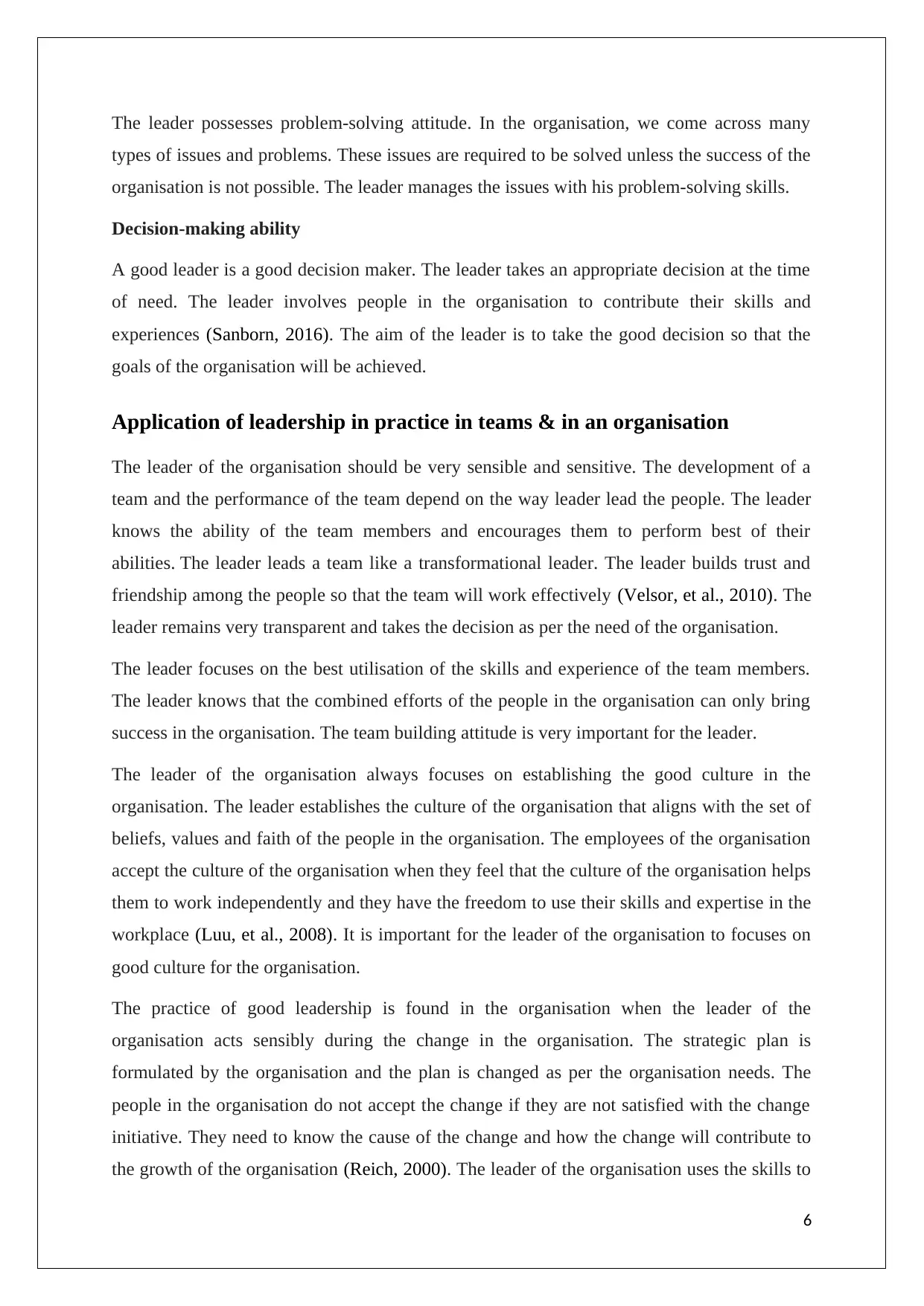
The leader possesses problem-solving attitude. In the organisation, we come across many
types of issues and problems. These issues are required to be solved unless the success of the
organisation is not possible. The leader manages the issues with his problem-solving skills.
Decision-making ability
A good leader is a good decision maker. The leader takes an appropriate decision at the time
of need. The leader involves people in the organisation to contribute their skills and
experiences (Sanborn, 2016). The aim of the leader is to take the good decision so that the
goals of the organisation will be achieved.
Application of leadership in practice in teams & in an organisation
The leader of the organisation should be very sensible and sensitive. The development of a
team and the performance of the team depend on the way leader lead the people. The leader
knows the ability of the team members and encourages them to perform best of their
abilities. The leader leads a team like a transformational leader. The leader builds trust and
friendship among the people so that the team will work effectively (Velsor, et al., 2010). The
leader remains very transparent and takes the decision as per the need of the organisation.
The leader focuses on the best utilisation of the skills and experience of the team members.
The leader knows that the combined efforts of the people in the organisation can only bring
success in the organisation. The team building attitude is very important for the leader.
The leader of the organisation always focuses on establishing the good culture in the
organisation. The leader establishes the culture of the organisation that aligns with the set of
beliefs, values and faith of the people in the organisation. The employees of the organisation
accept the culture of the organisation when they feel that the culture of the organisation helps
them to work independently and they have the freedom to use their skills and expertise in the
workplace (Luu, et al., 2008). It is important for the leader of the organisation to focuses on
good culture for the organisation.
The practice of good leadership is found in the organisation when the leader of the
organisation acts sensibly during the change in the organisation. The strategic plan is
formulated by the organisation and the plan is changed as per the organisation needs. The
people in the organisation do not accept the change if they are not satisfied with the change
initiative. They need to know the cause of the change and how the change will contribute to
the growth of the organisation (Reich, 2000). The leader of the organisation uses the skills to
6
types of issues and problems. These issues are required to be solved unless the success of the
organisation is not possible. The leader manages the issues with his problem-solving skills.
Decision-making ability
A good leader is a good decision maker. The leader takes an appropriate decision at the time
of need. The leader involves people in the organisation to contribute their skills and
experiences (Sanborn, 2016). The aim of the leader is to take the good decision so that the
goals of the organisation will be achieved.
Application of leadership in practice in teams & in an organisation
The leader of the organisation should be very sensible and sensitive. The development of a
team and the performance of the team depend on the way leader lead the people. The leader
knows the ability of the team members and encourages them to perform best of their
abilities. The leader leads a team like a transformational leader. The leader builds trust and
friendship among the people so that the team will work effectively (Velsor, et al., 2010). The
leader remains very transparent and takes the decision as per the need of the organisation.
The leader focuses on the best utilisation of the skills and experience of the team members.
The leader knows that the combined efforts of the people in the organisation can only bring
success in the organisation. The team building attitude is very important for the leader.
The leader of the organisation always focuses on establishing the good culture in the
organisation. The leader establishes the culture of the organisation that aligns with the set of
beliefs, values and faith of the people in the organisation. The employees of the organisation
accept the culture of the organisation when they feel that the culture of the organisation helps
them to work independently and they have the freedom to use their skills and expertise in the
workplace (Luu, et al., 2008). It is important for the leader of the organisation to focuses on
good culture for the organisation.
The practice of good leadership is found in the organisation when the leader of the
organisation acts sensibly during the change in the organisation. The strategic plan is
formulated by the organisation and the plan is changed as per the organisation needs. The
people in the organisation do not accept the change if they are not satisfied with the change
initiative. They need to know the cause of the change and how the change will contribute to
the growth of the organisation (Reich, 2000). The leader of the organisation uses the skills to
6
⊘ This is a preview!⊘
Do you want full access?
Subscribe today to unlock all pages.

Trusted by 1+ million students worldwide
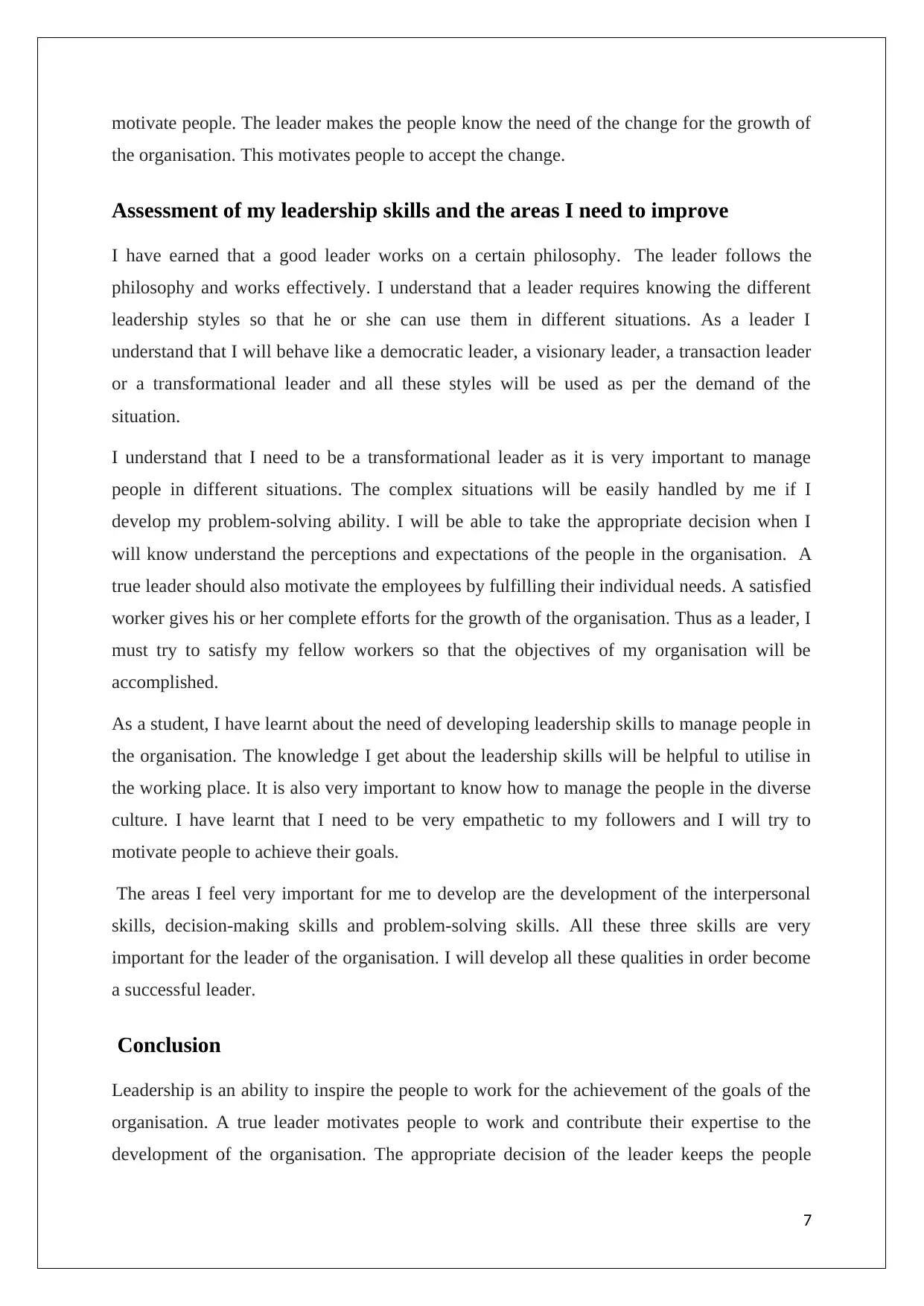
motivate people. The leader makes the people know the need of the change for the growth of
the organisation. This motivates people to accept the change.
Assessment of my leadership skills and the areas I need to improve
I have earned that a good leader works on a certain philosophy. The leader follows the
philosophy and works effectively. I understand that a leader requires knowing the different
leadership styles so that he or she can use them in different situations. As a leader I
understand that I will behave like a democratic leader, a visionary leader, a transaction leader
or a transformational leader and all these styles will be used as per the demand of the
situation.
I understand that I need to be a transformational leader as it is very important to manage
people in different situations. The complex situations will be easily handled by me if I
develop my problem-solving ability. I will be able to take the appropriate decision when I
will know understand the perceptions and expectations of the people in the organisation. A
true leader should also motivate the employees by fulfilling their individual needs. A satisfied
worker gives his or her complete efforts for the growth of the organisation. Thus as a leader, I
must try to satisfy my fellow workers so that the objectives of my organisation will be
accomplished.
As a student, I have learnt about the need of developing leadership skills to manage people in
the organisation. The knowledge I get about the leadership skills will be helpful to utilise in
the working place. It is also very important to know how to manage the people in the diverse
culture. I have learnt that I need to be very empathetic to my followers and I will try to
motivate people to achieve their goals.
The areas I feel very important for me to develop are the development of the interpersonal
skills, decision-making skills and problem-solving skills. All these three skills are very
important for the leader of the organisation. I will develop all these qualities in order become
a successful leader.
Conclusion
Leadership is an ability to inspire the people to work for the achievement of the goals of the
organisation. A true leader motivates people to work and contribute their expertise to the
development of the organisation. The appropriate decision of the leader keeps the people
7
the organisation. This motivates people to accept the change.
Assessment of my leadership skills and the areas I need to improve
I have earned that a good leader works on a certain philosophy. The leader follows the
philosophy and works effectively. I understand that a leader requires knowing the different
leadership styles so that he or she can use them in different situations. As a leader I
understand that I will behave like a democratic leader, a visionary leader, a transaction leader
or a transformational leader and all these styles will be used as per the demand of the
situation.
I understand that I need to be a transformational leader as it is very important to manage
people in different situations. The complex situations will be easily handled by me if I
develop my problem-solving ability. I will be able to take the appropriate decision when I
will know understand the perceptions and expectations of the people in the organisation. A
true leader should also motivate the employees by fulfilling their individual needs. A satisfied
worker gives his or her complete efforts for the growth of the organisation. Thus as a leader, I
must try to satisfy my fellow workers so that the objectives of my organisation will be
accomplished.
As a student, I have learnt about the need of developing leadership skills to manage people in
the organisation. The knowledge I get about the leadership skills will be helpful to utilise in
the working place. It is also very important to know how to manage the people in the diverse
culture. I have learnt that I need to be very empathetic to my followers and I will try to
motivate people to achieve their goals.
The areas I feel very important for me to develop are the development of the interpersonal
skills, decision-making skills and problem-solving skills. All these three skills are very
important for the leader of the organisation. I will develop all these qualities in order become
a successful leader.
Conclusion
Leadership is an ability to inspire the people to work for the achievement of the goals of the
organisation. A true leader motivates people to work and contribute their expertise to the
development of the organisation. The appropriate decision of the leader keeps the people
7
Paraphrase This Document
Need a fresh take? Get an instant paraphrase of this document with our AI Paraphraser

work without any worries and anxiety. The good culture also helps the employees to be very
productive in the workplace. The problem-solving attitudes and interpersonal skills are very
important for the leader. I understand that in order to be very successful in my workplace as a
leader I need to develop my skills and should know how and where I should use the different
styles of leadership. I must act like a visionary leader and lead the people in the correct
direction. I will focus on establishing good work culture among the team members and
motivate all to work collectively. This will help me to be a successful leader.
8
productive in the workplace. The problem-solving attitudes and interpersonal skills are very
important for the leader. I understand that in order to be very successful in my workplace as a
leader I need to develop my skills and should know how and where I should use the different
styles of leadership. I must act like a visionary leader and lead the people in the correct
direction. I will focus on establishing good work culture among the team members and
motivate all to work collectively. This will help me to be a successful leader.
8
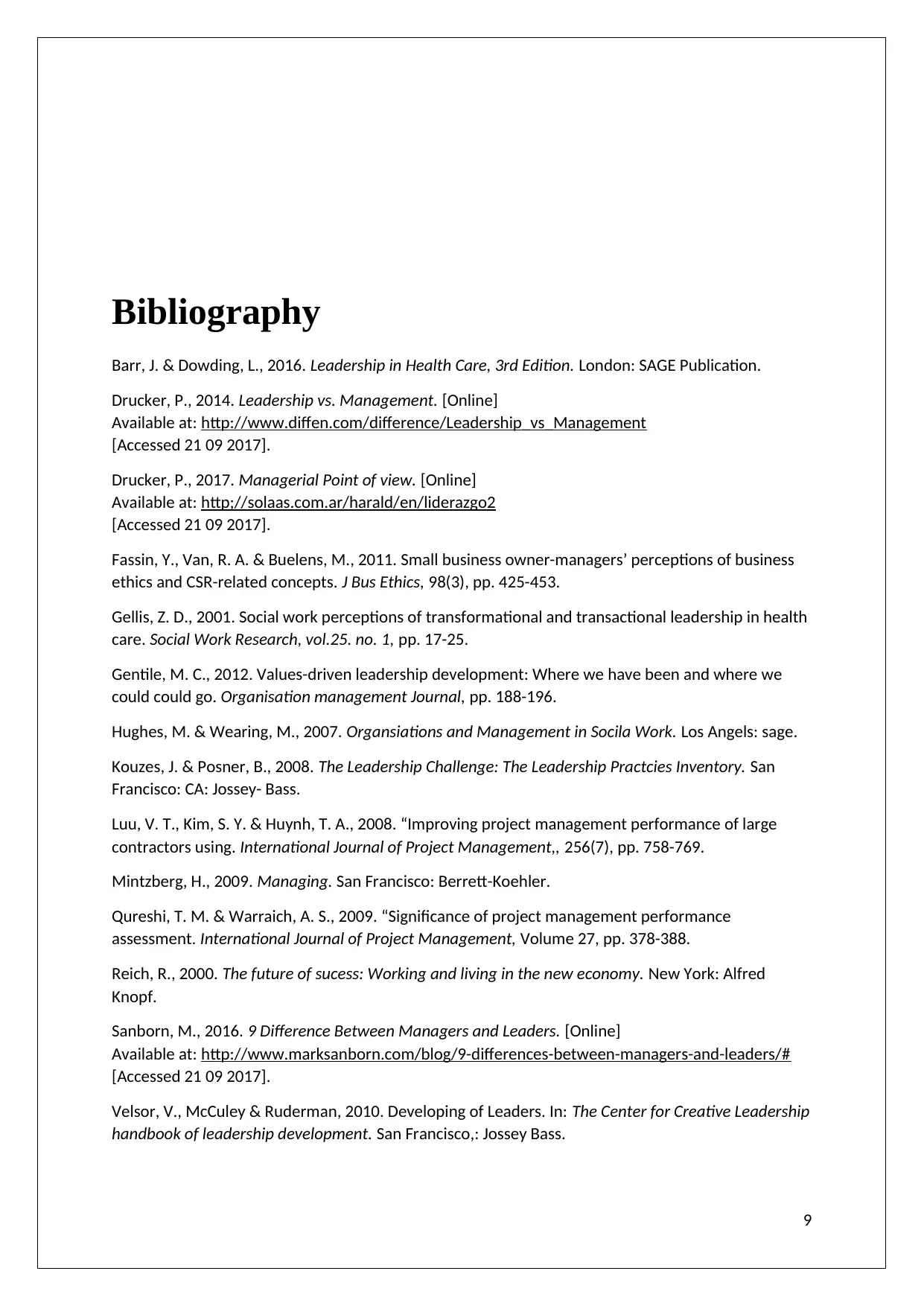
Bibliography
Barr, J. & Dowding, L., 2016. Leadership in Health Care, 3rd Edition. London: SAGE Publication.
Drucker, P., 2014. Leadership vs. Management. [Online]
Available at: http://www.diffen.com/difference/Leadership_vs_Management
[Accessed 21 09 2017].
Drucker, P., 2017. Managerial Point of view. [Online]
Available at: http;//solaas.com.ar/harald/en/liderazgo2
[Accessed 21 09 2017].
Fassin, Y., Van, R. A. & Buelens, M., 2011. Small business owner-managers’ perceptions of business
ethics and CSR-related concepts. J Bus Ethics, 98(3), pp. 425-453.
Gellis, Z. D., 2001. Social work perceptions of transformational and transactional leadership in health
care. Social Work Research, vol.25. no. 1, pp. 17-25.
Gentile, M. C., 2012. Values-driven leadership development: Where we have been and where we
could could go. Organisation management Journal, pp. 188-196.
Hughes, M. & Wearing, M., 2007. Organsiations and Management in Socila Work. Los Angels: sage.
Kouzes, J. & Posner, B., 2008. The Leadership Challenge: The Leadership Practcies Inventory. San
Francisco: CA: Jossey- Bass.
Luu, V. T., Kim, S. Y. & Huynh, T. A., 2008. “Improving project management performance of large
contractors using. International Journal of Project Management,, 256(7), pp. 758-769.
Mintzberg, H., 2009. Managing. San Francisco: Berrett-Koehler.
Qureshi, T. M. & Warraich, A. S., 2009. “Significance of project management performance
assessment. International Journal of Project Management, Volume 27, pp. 378-388.
Reich, R., 2000. The future of sucess: Working and living in the new economy. New York: Alfred
Knopf.
Sanborn, M., 2016. 9 Difference Between Managers and Leaders. [Online]
Available at: http://www.marksanborn.com/blog/9-differences-between-managers-and-leaders/#
[Accessed 21 09 2017].
Velsor, V., McCuley & Ruderman, 2010. Developing of Leaders. In: The Center for Creative Leadership
handbook of leadership development. San Francisco,: Jossey Bass.
9
Barr, J. & Dowding, L., 2016. Leadership in Health Care, 3rd Edition. London: SAGE Publication.
Drucker, P., 2014. Leadership vs. Management. [Online]
Available at: http://www.diffen.com/difference/Leadership_vs_Management
[Accessed 21 09 2017].
Drucker, P., 2017. Managerial Point of view. [Online]
Available at: http;//solaas.com.ar/harald/en/liderazgo2
[Accessed 21 09 2017].
Fassin, Y., Van, R. A. & Buelens, M., 2011. Small business owner-managers’ perceptions of business
ethics and CSR-related concepts. J Bus Ethics, 98(3), pp. 425-453.
Gellis, Z. D., 2001. Social work perceptions of transformational and transactional leadership in health
care. Social Work Research, vol.25. no. 1, pp. 17-25.
Gentile, M. C., 2012. Values-driven leadership development: Where we have been and where we
could could go. Organisation management Journal, pp. 188-196.
Hughes, M. & Wearing, M., 2007. Organsiations and Management in Socila Work. Los Angels: sage.
Kouzes, J. & Posner, B., 2008. The Leadership Challenge: The Leadership Practcies Inventory. San
Francisco: CA: Jossey- Bass.
Luu, V. T., Kim, S. Y. & Huynh, T. A., 2008. “Improving project management performance of large
contractors using. International Journal of Project Management,, 256(7), pp. 758-769.
Mintzberg, H., 2009. Managing. San Francisco: Berrett-Koehler.
Qureshi, T. M. & Warraich, A. S., 2009. “Significance of project management performance
assessment. International Journal of Project Management, Volume 27, pp. 378-388.
Reich, R., 2000. The future of sucess: Working and living in the new economy. New York: Alfred
Knopf.
Sanborn, M., 2016. 9 Difference Between Managers and Leaders. [Online]
Available at: http://www.marksanborn.com/blog/9-differences-between-managers-and-leaders/#
[Accessed 21 09 2017].
Velsor, V., McCuley & Ruderman, 2010. Developing of Leaders. In: The Center for Creative Leadership
handbook of leadership development. San Francisco,: Jossey Bass.
9
⊘ This is a preview!⊘
Do you want full access?
Subscribe today to unlock all pages.

Trusted by 1+ million students worldwide

10
1 out of 10
Related Documents
Your All-in-One AI-Powered Toolkit for Academic Success.
+13062052269
info@desklib.com
Available 24*7 on WhatsApp / Email
![[object Object]](/_next/static/media/star-bottom.7253800d.svg)
Unlock your academic potential
Copyright © 2020–2025 A2Z Services. All Rights Reserved. Developed and managed by ZUCOL.




